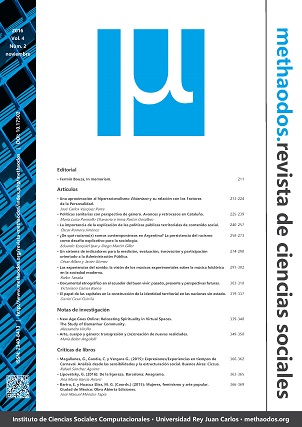Sound experiences: the vision of experimental musician on the folkloric music in modern society
Main Article Content
Abstract
This work begins narrating how folk music has always been a remnant in the influence on classical composers. It makes special mention of origin Hungarian musicians Bela Bartok, Zoltan Kodaly. This Musicians are considerate in this work as the most immediate ancestors of an experimental musicians northamericans, because both are influenced by their passion for folk music. We select as musicians principals exponents of American experimental music to John Cage, Lou Harrison and Carl Ruggles. Their works will be considered and analyzed in this text as the sounds as the experiences. Composers that will analyze the sound as experience, as feeling, as emotion, as time and origin. related traits in folk music and experimental music. Not forgetting in this work, and in his final considerations, the relationship between the musician, creation, society and art.
Downloads
Article Details
References
Bartók, B. (2006): Escritos sobre música popular. México: Siglo XXI.
Bartók, B; ed. (1976): Benjamin Suchoff. Béla Bartók Essays. Nebraska: Lincoln. University of Nebraska Press.
Bateson, G. (1976): Style, Grace and Information in Primitive art. In Steps to an Ecology of Mind. New York: Ballantine.
Bergson, L. (1900): Henri. Le rire. Paris: Presses Universitaires de France.
Cage, J. (1981): For the Birds John Cage in conversation with Daniel Charles. London: Marion Boyars Publishers Ltd.
Castoriadis, C. (2013): La institución imaginaria de la sociedad. Barcelona: Tusquets.
Greenaway, P. (2006): DVD John Cage; Robert Ashley: 4 American composers, produced by Trans Atlantic Films for Channel Four Television IMAGICA TV.
Grainger, A. (1991): “Percy. The Impress of Personality in Unwritten Music”, The Musical Quarterly, 75(4): 1-18
Harrison, L. (1946): About Carl Ruggles. Yonkers: New York. http://dx.doi.org/10.1093/mq/75.4.1
— (ed.) (1993): Toshie Kakinuma and Mamoru. Fujieda. Music primer. Tokyo: Jesuku Ongaku Bunka Shinkokai.
Hesselink, N. (1999): “Kim Inu's "P'ungmulgut and Communal Spirit": Edited and Translated with an Introduction and Commentary”, Asian Music (Society for Asian Music), 31 (1): 1-34. http://dx.doi.org/10.2307/834278
— (2004): “Samul nori as Traditional: Preservation and Innovation in a South Korean Contemporary Percussion Genre”, Ethnomusicology (Society for Ethnomusicology), 48 (3): 405-439.
— (2006): Pungmul: South Korean Drumming and Dance. Chicago: University of Chicago Press. http://dx.doi.org/10.1017/S0021911808002155
— (2007): “Taking Culture Seriously: Democratic Music and Its Transformative Potential in South Korea”, The World of Music, 49 (3): 75-106.
— (2009), “Yŏngdong Nongak: Mountains, Music, and the Samulnori Canon”, Acta Koreana Keimyung University, 12 (1): 1-26. http://dx.doi.org/10.18399/acta.2009.12.1.001
Johnson, J. (2002): “Who Needs Classical Music?: Cultural Choice and Musical Value”, Popular Music, 23 (2): 227-229. http://dx.doi.org/10.1017/S0261143004230112
Kahn, D. (1997): “John Cage: Silence and Silencing”, The Musical Quarterly, 81. (4): 556-598. http://dx.doi.org/10.1093/mq/81.4.556
Kwon, D. L. (2001): “The Roots and Routes of Pungmul in the United States”, Music and Culture (Korean Society for World Music), 5: 39-65.
McPhee, C. (1949): “The Five-Tone Gamelan Music of Bali”, The Musical Quarterly, 35(2): 250-281. http://dx.doi.org/10.1093/mq/XXXV.2.250
Morgan, R. (1994): La música del Siglo XX. Madrid: Ed. Akal.
Olali, T. (2015): “Performing the Swahili Hamziyyah and the pyeongtaek Nongak: A comparative Analysis of Community Dance and Ritual”, American Research Journal of Humanities and Social Sciences, 1(2): 41-48.
Orrego, J. (1945): "La creación musical contemporánea en los Estados Unidos. Algunas consideraciones sobre sus principales tendencias”, Revista Musical Chilena, 1 (4). 14-27.
Roy, M. (2003): Músicas cubanas. Madrid: AKAL.
Seeger, C. (1932): “Carl Ruggles”, The Musical Quarterly, 18(4): 578-592. http://dx.doi.org/10.1093/mq/XVIII.4.578
Stevens, H. y Gillies, M. (1993). The life and Music of Béla Bartók. London: Oxford University Press.
Tanaka, R. (2009): “Nonverbal Communication with Respect to "Performing Art Value": A Case Study in the Meaning of "NONGAK" in South Korea. Next Generation”, Social Sciences and Humanities Research, (5): 296-315. (in japanes).
— (2013): “Tradition/Modern, Convergence of Arts: An Anthropological Perspective on Experiencing Sound”, Culture and Representation, (9): 22-49. (in japanes).

